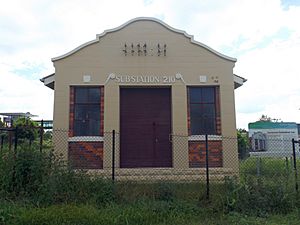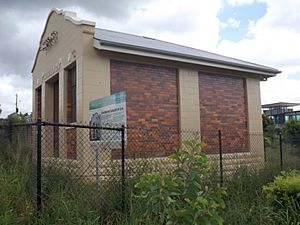Coorparoo Substation No. 210 facts for kids
Quick facts for kids Coorparoo Substation No. 210 |
|
|---|---|

Front view, 2015
|
|
| Location | 12 Main Avenue, Coorparoo, City of Brisbane, Queensland, Australia |
| Design period | 1919–1930s (interwar period) |
| Built | 1930 |
| Architect | Reyburn Jameson |
| Architectural style(s) | Spanish Mission |
| Official name: Coorparoo Substation No. 210, Substation 10 | |
| Type | state heritage (built) |
| Designated | 1 August 2005 |
| Reference no. | 602495 |
| Significant period | 1930-c. 1977 (historical) 1930s (fabric) |
| Significant components | sign, furniture/fittings, electricity substation, views to |
| Builders | A. Mason |
| Lua error in Module:Location_map at line 420: attempt to index field 'wikibase' (a nil value). | |
The Coorparoo Substation No. 210 is a special old building in Coorparoo, Brisbane, Queensland, Australia. It's listed as a heritage site because it played an important part in how Brisbane got its electricity. Designed by Reyburn Jameson and built in 1930 by A. Mason, this small building helped power the streetlights in the area for many years. It's also known as Substation 10.
Contents
Powering Brisbane: A Look Back
This substation is located on Main Avenue, Coorparoo, right next to Langlands Park. It's a small, one-story building made of concrete blocks and brick. It was built in 1930 to supply electricity for the streetlights in Coorparoo.
Early Electricity in Brisbane
Electricity first came to Brisbane in 1882. At that time, J.W. Sutton and Company showed off eight street lamps powered by a steam engine. This was a big deal, as it was the same year that electricity started being supplied to homes and businesses in other parts of the world.
A company called Barton and White started in 1887. By 1888, they had a small power station. The General Post Office was the very first customer to get electricity in Australia from this company! Over time, Barton and White became the City Electric Light Company (CEL).
Trams and More Power
Brisbane's first electric trams started running in 1897. The company that ran the trams also had its own power stations. As the tram lines grew, more power stations were needed.
In 1925, the Greater Brisbane Council took over the tram system. They realized that Brisbane's electricity network was old and needed a big upgrade. This led to a fast expansion of the electricity system in the late 1920s.
New Farm Power Station
A major step was when the New Farm power station opened in 1928. This new station was much more powerful and helped supply electricity to many parts of Brisbane. After it opened, the older, smaller power stations were closed down.
AC vs. DC: A Big Change
Electricity can be supplied in two main ways: Direct Current (DC) or Alternating Current (AC).
- DC was good for short distances, like powering trams nearby.
- AC could be easily changed in voltage using devices called transformers. This meant high voltage AC could travel long distances on thinner wires, then be "stepped down" to lower voltages for homes and businesses.
This change to AC was very important because it allowed electricity to reach large areas easily. It meant fewer local power plants were needed. The substations built in the 1920s and 1930s, like Coorparoo, were part of this big shift to modern AC distribution.
Why Coorparoo Needed a Substation
The Coorparoo area's agreement for electricity supply ended in 1930. At the same time, Brisbane decided to change its street lighting to a "series system." In this system, streetlights are connected in a loop, and the current flows through each lamp in turn. This system needed a special substation to manage the power.
The Coorparoo Substation was built to control the street lighting for the whole south side of the Brisbane River. A. Mason built it, and the City Architect's Office designed it. Reyburn Jameson signed the plans. It was unusual because it was built with 200-millimetre (7.9 in) concrete blocks, which was not common for these types of buildings back then.
The substation was not staffed by people. It had a special timer to turn the streetlights on and off based on sunrise and sunset. It took 11,000 volts of power from a main substation and "stepped it down" to 5,000 volts for the streetlights.
The End of an Era
In the 1960s, the series system for street lighting started to be replaced by the "parallel system," which is what we mostly use today. By 1977, the Coorparoo Substation No. 210 was disconnected and no longer used for street lighting. For a while, it was used for storage by the local bowls club, but now it is empty.
What the Substation Looks Like
The former Coorparoo Substation No. 210 is a simple, single-story building. It's made of 200-millimetre (7.9 in) white-painted cement blocks with red brick panels. It sits on a concrete base.
The roof is made of corrugated iron and has a curved, decorative gable on the front. You can still see where insulators (which stop electricity from escaping) used to stick out from the top. There's a large steel roller door on the front, with a smaller door inside it.
The sides of the building have no windows, but the back (western side) has two small windows. There are also vents near the floor and gaps under the roof to help air flow through the building, which was important for cooling the electrical equipment inside.
Inside, it's one open space. You can still see where machines and cables were once connected to the walls and floor.
Why It's a Heritage Site
Coorparoo Substation No. 210 was added to the Queensland Heritage Register on 1 August 2005 for several reasons:
- Part of History: It shows how Brisbane's electricity supply was modernized in the late 1920s and 1930s. This helped improve homes, businesses, and public transport like trams. It also shows how Brisbane used the "series system" for street lighting, which is no longer used.
- Uncommon Design: It was rare for the City Architect's Office to use concrete blocks for buildings like this back then. Also, it was one of only three 11,000-volt street lighting substations built by 1940, and it's the only one still owned by the Brisbane City Council.
- Typical Substation Features: It's a good example of a small, strong, brick substation from that time. Its open inside space, vents, and roller door were common features for buildings holding electrical equipment.
- Attractive Design: The substation has a nice, "picturesque" design. The City Architect wanted these buildings to look good in residential areas, showing how important the council thought its electricity project was.
- Council's Work: It's strongly connected to the Brisbane City Council and its efforts to organize Brisbane's electricity supply after the Greater Brisbane Council was formed in 1925.


